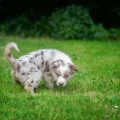Dogs can be great companions, but they can also be unpredictable at times. As a pet owner, it can be concerning when your dog shows aggressive behavior towards your child. If your dog has snapped at your child, it’s important to take immediate action to prevent any future incidents.
First and foremost, it’s important to understand that punishment is not an effective way to deal with aggressive behavior in dogs. Punishing your dog can actually make the problem worse and increase the risk of further aggression. Instead, it’s important to work with a professional dog trainer or behaviorist who can guide you in the process of modifying your dog’s behavior.
One common reason for dog aggression towards children is fear. If your dog is afraid of your child or any child, it’s important to address this fear and help your dog feel more comfortable around children. This can be done by gradually exposing your dog to children in a positive and controlled environment.
Counter conditioning is a technique that can be used to help your dog associate positive experiences with the presence of children. This involves rewarding your dog with treats and praise when they show calm and relaxed behavior around children. Over time, this can help your dog feel more comfortable and less fearful in the presence of children.
It’s also important to address any underlying issues that may be contributing to your dog’s aggression. For example, if your dog is possessive of toys or food, it’s important to address this issue and teach your dog that sharing is a positive thing.
In addition to working with a professional trainer or behaviorist, there are also some steps you can take at home to help prevent future incidents. These include supervising interactions between your dog and your child, teaching your child to respect your dog’s boundaries, and providing your dog with plenty of exercise and mental stimulation.
If your dog has snapped at your child, it’s important to take immediate action to address the issue. Punishment is not an effective way to deal with aggressive behavior in dogs, and it’s important to work with a professional trainer or behaviorist who can guide you in the process of modifying your dog’s behavior. By taking a proactive approach and addressing any underlying issues, you can help ensure that your dog and your child can coexist safely and happily.

Punishing a Dog for Snapping: Is It Necessary?
When it comes to the question of whether or not to punish a dog for snapping, the answer is no. Punishing a dog for snapping can actually worsen the behavior and cause the dog to become more aggressive. Instead, it is important to identify the underlying cause of the behavior and address it through positive reinforcement training, desensitization, and counter-conditioning. It is also important to ensure that the dog is not in a situation where it feels threatened or uncomfortable. Punishment can lead to fear, anxiety, and stress, which can exacerbate the problem and potentially lead to other behavioral issues. It is always best to seek the guidance of a professional dog trainer or behaviorist to properly address any aggression or behavioral issues in your dog.
Disciplining a Dog for Snapping
Disciplining a dog for snapping involves a process called counter conditioning. This process requires the use of treats, preferably small ones. The first step is to identify what triggers your dog to snap. Once you have identified these triggers, you can begin to desensitize your dog to them. This means gradually exposing your dog to the trigger in a controlled environment, while rewarding him with treats when he reacts calmly.
It’s important to note that this process is not a quick fix and may take some time. Consistency is key when it coms to counter conditioning, and it’s important to remain patient and persistent. Additionally, it’s important to avoid punishing your dog for snapping, as this can actually make the behavior worse. Instead, focus on positive reinforcement techniques such as counter conditioning to encourage your dog to behave appropriately.
The key to disciplining a dog for snapping is to identify the trigger, desensitize your dog to it, and reward him for reacting calmly. With patience and consistency, you can help your dog overcome this behavior and become a well-behaved companion.
The Reasons Why a Dog May Snap at a Child
Dog aggression towards children can occur due to various reasons, but the most common cause is fear. Dogs may become frightened by the sudden movements or loud noises of children, leading them to snap or bite as a form of self-defense. In addition, dogs that have never been socialized with children or have had negative experiences with them may be more prone to aggression.
Other factors that can contribute to dog aggression towards children include possessiveness over toys or food, territorial behavior, and lack of training or proper socialization. It is important for dog owners to be vigilant and supervise their pets around children, as well as teach children how to behave around dogs in a safe and respectful manner.
According to the Centers for Disease Control and Prevention, around 800,000 people seek medical attention for dog bites each year, with approximately half of these being children. It is essential for dog owners to understand the potential triggers for their pet’s aggression and take steps to prevent any harmful incidents from occurring.
The Consequences of a Dog Biting a Child
In some states, dogs that bite children may be put down, but the laws regarding this issue vary from state to state. In California, for instance, a dog that bites someone is not automatically put down. Instead, the owners of the dog are held liable for the injury caused by the dog, and the severity of the bite, the dog’s history of aggression, and other factors may be taken into account when determining the appropriate course of action. In some cases, the dog may be required to undergo training and behavior modification, or the owners may be required to take additional safety measures to prevent future incidents. However, ultimately, the decision about whether or not to put the dog down will depend on the specific circumstances of the case.
Conclusion
Dogs are wonderful companions, but it’s important to be aware of their behavior and understand how to modify it if necessary. Aggression towards children is a serious issue that requires careful attention and patience. Punishment is not the answer and can often make the problem worse. Instead, counter conditioning with treats and desensitization to triggers is the recommended approach. It’s important to remember that dogs are often aggressive out of fear, so it’s crucial to create a safe and positive environment for them. With proper training and care, dogs can be loving and loyal companions for years to come.












